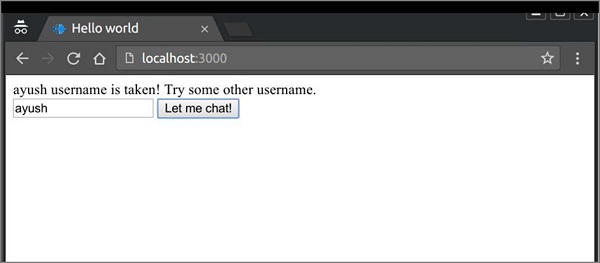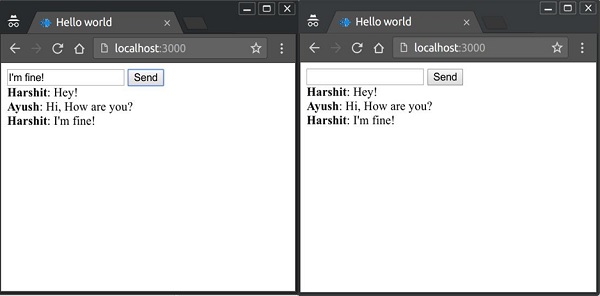
- Socket.IO Tutorial
- Socket.IO - Home
- Socket.IO - Overview
- Socket.IO - Environment
- Socket.IO - Hello world
- Socket.IO - Event Handling
- Socket.IO - Broadcasting
- Socket.IO - Namespaces
- Socket.IO - Rooms
- Socket.IO - Error Handling
- Socket.IO - Logging & Debugging
- Socket.IO - Internals
- Socket.IO - Chat Application
- Socket.IO Useful Resources
- Socket.IO - Quick Guide
- Socket.IO - Useful Resources
- Socket.IO - Discussion
Socket.IO - Chat Application
Now that we are well acquainted with Socket.IO, let us write a chat application, which we can use to chat on different chat rooms. We will allow users to choose a username and allow them to chat using them. So first, let us set up our HTML file to request for a username −
<!DOCTYPE html>
<html>
<head><title>Hello world</title></head>
<script src="/socket.io/socket.io.js"></script>
<script>
var socket = io();
</script>
<body>
<input type="text" name="name" value="" placeholder="Enter your name!">
<button type="button" name="button">Let me chat!</button>
</body>
</html>
Now that we have set up our HTML to request for a username, let us create the server to accept connections from the client. We will allow people to send their chosen usernames using the setUsername event. If a user exists, we will respond by a userExists event, else using a userSet event.
var app = require('express')();
var http = require('http').Server(app);
var io = require('socket.io')(http);
app.get('/', function(req, res){
res.sendFile('E:/test/index.html');});
users = [];
io.on('connection', function(socket){
console.log('A user connected');
socket.on('setUsername', function(data){
if(users.indexOf(data) > -1){
users.push(data);
socket.emit('userSet', {username: data});
} else {
socket.emit('userExists', data + ' username is taken! Try some other username.');
}
})
});
http.listen(3000, function(){
console.log('listening on localhost:3000');
});
We need to send the username to the server when people click on the button. If user exists, we show an error message; else, we show a messaging screen −
<!DOCTYPE html>
<html>
<head><title>Hello world</title></head>
<script src="/socket.io/socket.io.js"></script>
<script>
var socket = io();
function setUsername(){
socket.emit('setUsername', document.getElementById('name').value);
};
var user;
socket.on('userExists', function(data){
document.getElementById('error-container').innerHTML = data;
});
socket.on('userSet', function(data){
user = data.username;
document.body.innerHTML = '<input type="text" id="message">\
<button type="button" name="button" onclick="sendMessage()">Send</button>\
<div id="message-container"></div>';
});
function sendMessage(){
var msg = document.getElementById('message').value;
if(msg){
socket.emit('msg', {message: msg, user: user});
}
}
socket.on('newmsg', function(data){
if(user){
document.getElementById('message-container').innerHTML +='<div><b>' + data.user + '</b>: ' + data.message + '</div>'
}
})
</script>
<body>
<div id="error-container"></div>
<input id="name" type="text" name="name" value="" placeholder="Enter your name!">
<button type="button" name="button" onclick="setUsername()">Let me chat!</button>
</body>
</html>
Now if you connect two clients with same username, it will give you an error as shown in the screenshot below −

Once you have provided an acceptable username, you will be taken to a screen with a message box and a button to send messages. Now, we have to handle and direct the messages to the connected client. For that, modify your app.js file to include the following changes −
var app = require('express')();
var http = require('http').Server(app);
var io = require('socket.io')(http);
app.get('/', function(req, res){
res.sendFile('E:/test/index.html');});
users = [];
io.on('connection', function(socket){
console.log('A user connected');
socket.on('setUsername', function(data){
console.log(data);
if(users.indexOf(data) > -1){
socket.emit('userExists', data + ' username is taken! Try some other username.');
} else {
users.push(data);
socket.emit('userSet', {username: data});
}
});
socket.on('msg', function(data){
//Send message to everyone
io.sockets.emit('newmsg', data);
})
});
http.listen(3000, function(){
console.log('listening on localhost:3000');
});
Now connect any number of clients to your server, provide them a username and start chatting! In the following example, we have connected two clients with names Ayush and Harshit and sent some messages from both the clients −
